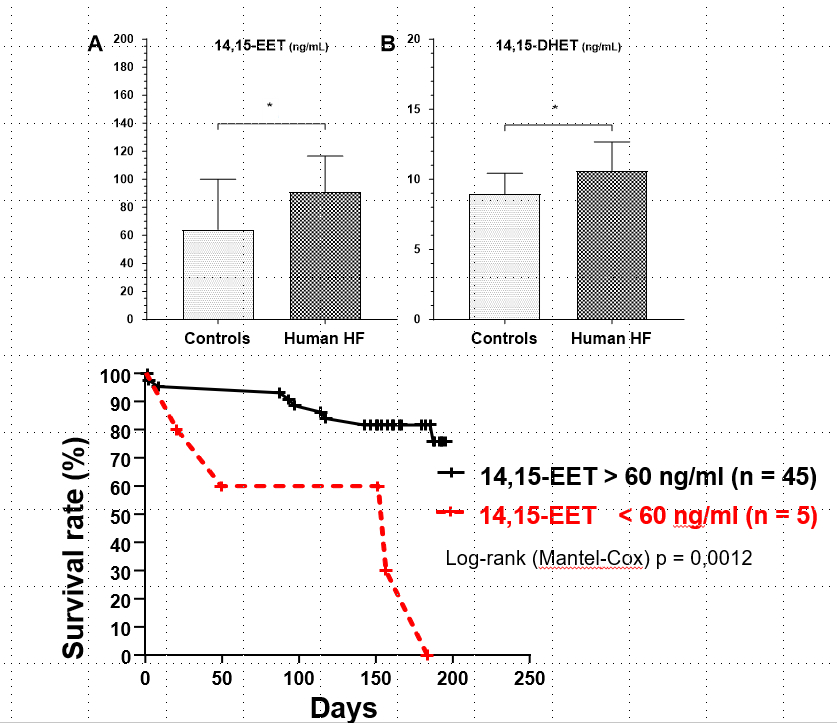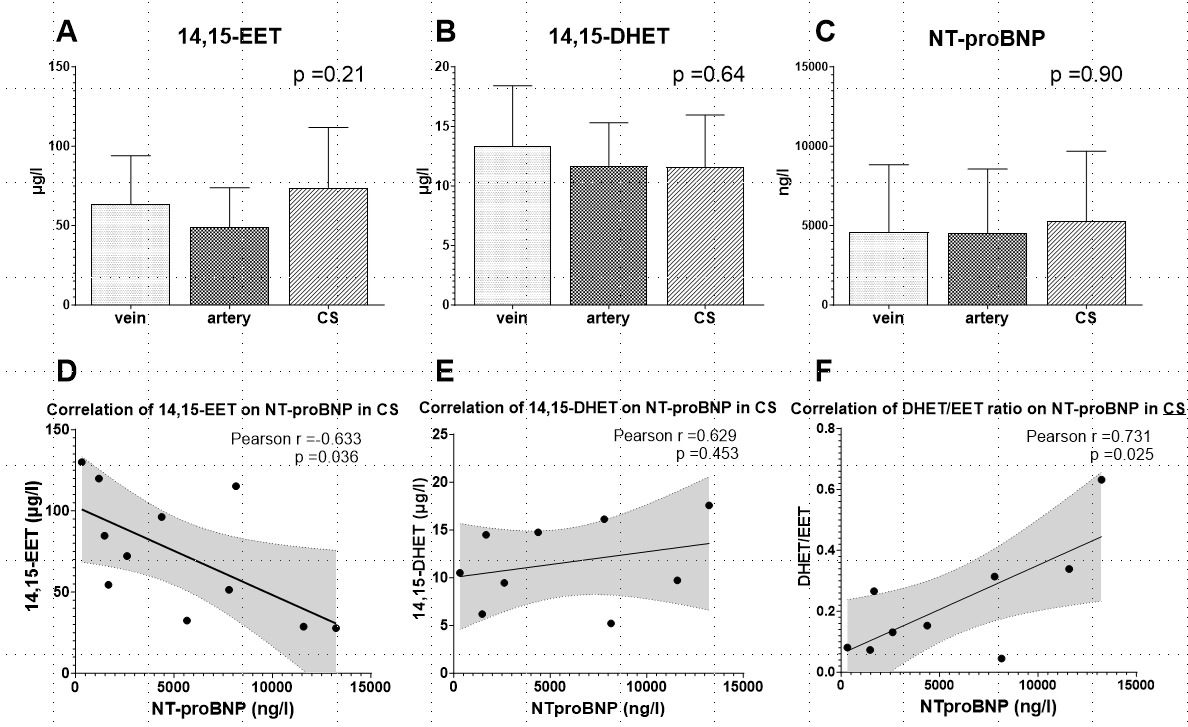Final ID: Mo031
Tissue deficiency and altered eicosanoids levels in rodent and human heart failure.
Abstract Body: Introduction
The role of eicosanoids, especially epoxyeicosatrienoic acids (EETs), metabolites of arachidonic acid with cardio-renal activity, in heart failure (HF) remains unclear.
Hypothesis
Altered eicosanoids turnover, both in rodent and human heart failure, is a part of the pathophysiology of HF and contributes to poor prognosis.
Methods
We measured active EETs and their biologically inactive metabolites, dihydroxyeicosatrienoic acids (DHETs) in the left ventricle (LV) and renal tissue obtained from a rodent heart failure model induced by aortocaval fistula (ACF). We measured protein expression of CYP2C23 and CYP2J3 in the kidney cortex and LV tissue by Western blot analysis to evaluate EETs production and mRNA expression of soluble epoxide hydrolase (sEH), the enzyme responsible for the degradation of EETs to DHETs. In the translational part, firstly, we enrolled 50 patients with HF to measure plasma 14,15-epoxyeicosatrienoic acid (14,15-EET) and 14,15-dihydroxyicosatrienoic acid (14,15-DHET) levels using commercial ELISA kits and compared them with 25 age- and sex-matched controls. Secondly, 11 consecutive patients with HFrEF indicated to cardiac resynchronization therapy (CRT) were enrolled to measure plasmatic 14,15-EET and 14,15-DHET levels in venous, arterial, and coronary sinus (CS) blood samples and correlate them with N-terminal pro-B-type natriuretic peptide (NT-proBNP) from the same compartments.
Results
ACF rats exhibited tissue deficiency of EETs in the LV and kidney compared to controls, probably mainly caused by increased EETs degradation by sEH (unchanged expressions of CYP2C23 and CYP2J3, increased mRNA of sEH and EETs/DHETs ratio). In humans, both of the measured eicosanoids were significantly higher in the HF group: 14,15-EET (91.3 ±25.7 vs. 64.95 ±35.4 ng/ml) and 14,15-DHET (10.58 ±2.06 vs. 9.07 ±1.60 ng/ml), p for both < 0.001. HF patients with 14,15-EET levels less than 60 ng/ml had worse short term mortality compared to those above. In CS, NT-proBNP levels negatively correlated with plasmatic 14,15-EET levels (r = -0.63, p = 0.03) and positively with the DHET/EET ratio (r = 0.73, p = 0.02). Plasmatic 14,15-EET nor 14,15-DHET levels in measured compartments did not differ statistically (p = 0.21, p = 0,64, respectively). In individual patients, the levels of both eicosanoids correlated across all compartments.
Conclusions
Tissue deficiency of active eicosanoids and their altered turnover may play an important role in HF pathophysiology.
The role of eicosanoids, especially epoxyeicosatrienoic acids (EETs), metabolites of arachidonic acid with cardio-renal activity, in heart failure (HF) remains unclear.
Hypothesis
Altered eicosanoids turnover, both in rodent and human heart failure, is a part of the pathophysiology of HF and contributes to poor prognosis.
Methods
We measured active EETs and their biologically inactive metabolites, dihydroxyeicosatrienoic acids (DHETs) in the left ventricle (LV) and renal tissue obtained from a rodent heart failure model induced by aortocaval fistula (ACF). We measured protein expression of CYP2C23 and CYP2J3 in the kidney cortex and LV tissue by Western blot analysis to evaluate EETs production and mRNA expression of soluble epoxide hydrolase (sEH), the enzyme responsible for the degradation of EETs to DHETs. In the translational part, firstly, we enrolled 50 patients with HF to measure plasma 14,15-epoxyeicosatrienoic acid (14,15-EET) and 14,15-dihydroxyicosatrienoic acid (14,15-DHET) levels using commercial ELISA kits and compared them with 25 age- and sex-matched controls. Secondly, 11 consecutive patients with HFrEF indicated to cardiac resynchronization therapy (CRT) were enrolled to measure plasmatic 14,15-EET and 14,15-DHET levels in venous, arterial, and coronary sinus (CS) blood samples and correlate them with N-terminal pro-B-type natriuretic peptide (NT-proBNP) from the same compartments.
Results
ACF rats exhibited tissue deficiency of EETs in the LV and kidney compared to controls, probably mainly caused by increased EETs degradation by sEH (unchanged expressions of CYP2C23 and CYP2J3, increased mRNA of sEH and EETs/DHETs ratio). In humans, both of the measured eicosanoids were significantly higher in the HF group: 14,15-EET (91.3 ±25.7 vs. 64.95 ±35.4 ng/ml) and 14,15-DHET (10.58 ±2.06 vs. 9.07 ±1.60 ng/ml), p for both < 0.001. HF patients with 14,15-EET levels less than 60 ng/ml had worse short term mortality compared to those above. In CS, NT-proBNP levels negatively correlated with plasmatic 14,15-EET levels (r = -0.63, p = 0.03) and positively with the DHET/EET ratio (r = 0.73, p = 0.02). Plasmatic 14,15-EET nor 14,15-DHET levels in measured compartments did not differ statistically (p = 0.21, p = 0,64, respectively). In individual patients, the levels of both eicosanoids correlated across all compartments.
Conclusions
Tissue deficiency of active eicosanoids and their altered turnover may play an important role in HF pathophysiology.
More abstracts on this topic:
Acute Rhythm Change Reveals Atrial-Specific Metabolomic and Lipidomic Alterations in Atrial Fibrillation
Kassar Ahmad, Bockus Lee, Haykal Romanos, Chamoun Nadia, Chahine Yaacoub, Al Yasiri Hala, Hensley Tori, Akoum Nazem
B-type Natriuretic Peptide Reverses Vascular Endothelial Insulin Resistance and Ameliorates Oxidative Stress in Human AtherosclerosisForan Daniel, Krasopoulos George, Srivastava Vivek, Sayeed Rana, Antonopoulos Alexios, Channon Keith, Akoumianakis Ioannis, Antoniades Charalambos, Badi Ileana, Polkinghorne Murray, Katsouda Antonia, Riering Marianne, Dalessio Andrea, Sastry Priya, Kourliouros Antonios, Walcot Nicholas



